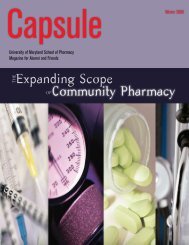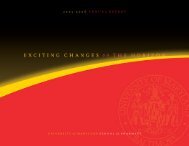Drug Discovery and Delivery - ScienceScribe.Net
Drug Discovery and Delivery - ScienceScribe.Net
Drug Discovery and Delivery - ScienceScribe.Net
You also want an ePaper? Increase the reach of your titles
YUMPU automatically turns print PDFs into web optimized ePapers that Google loves.
CMD<br />
Second year chemistry graduate student Wai Sheung Ma displays a high resolution NMR spectrum<br />
collected at a magnetic field strength of 11.7 Tesla (500MHz NMR spectrometer) at the USF<br />
Interdisciplinary NMR Facility, a Chemistry <strong>and</strong> CMD5 facility. The spectrometer is the highest magnetic<br />
field strength currently in existence at USF. Spectra like the one displayed on the monitor are used to<br />
study potential drugable protein sites by molecules that are synthesized by CMD5 researchers.<br />
86 RESEARCH | WWW.RESEARCH.USF.EDU
5<br />
USF researchers are<br />
creating biologically<br />
active compounds with<br />
pharmaceutical properties<br />
UNIVERSITY OF SOUTH FLORIDA | SPRING/SUMMER 2007<br />
7
CMD5<br />
By R<strong>and</strong>olph Fillmore<br />
Photos by Joseph Gamble<br />
As the<br />
University of<br />
South Florida<br />
enters its next 50 years,<br />
one of the pivotal<br />
moments future USF<br />
historians will likely cite<br />
as both a turning point in<br />
the University's<br />
commitment to research<br />
<strong>and</strong> an advancement that<br />
helped put USF research<br />
into the top echelons of<br />
university-based<br />
research, will be the<br />
establishment of CMD5—<br />
the Center for Molecular<br />
Diversity in <strong>Drug</strong> Design,<br />
<strong>Discovery</strong> <strong>and</strong> <strong>Delivery</strong>.<br />
“CMD5 represents both a synergy <strong>and</strong><br />
a consensus-driven venture between USF<br />
scientists from several diverse research<br />
disciplines,” says USF Chemistry Professor<br />
<strong>and</strong> Department Chair Mike Zaworotko.<br />
“CMD5 members are creating <strong>and</strong> using the<br />
most recent advances in molecular science to<br />
underst<strong>and</strong> the causes of human disease <strong>and</strong><br />
develop new ways to prevent <strong>and</strong> treat<br />
disease.”<br />
What Zaworotko is most enthusiastic<br />
about is the ability of CMD5 <strong>and</strong> USF to<br />
commercialize new drug lead compounds<br />
that participants in CMD5 discover. Those<br />
compounds, says Zaworotko, will be on the<br />
front lines of the next generation of<br />
pharmaceuticals that are not only designed<br />
for individuals as “personalized medicine,”<br />
but are also deliverycontrolled<br />
to<br />
molecular sites of<br />
action within the<br />
body.<br />
According to<br />
Zaworotko, the<br />
outside world has<br />
created ‘fertile<br />
ground’ for the<br />
initiative for the<br />
USF-based venture<br />
into drug discovery<br />
<strong>and</strong> design by<br />
interdisciplinary<br />
teams of medicinal<br />
chemists, biologists,<br />
<strong>and</strong> biochemists.<br />
“The business model for drug<br />
discovery, getting new drugs through the<br />
pipeline <strong>and</strong> into the marketplace, has<br />
changed dramatically,” explains Zaworotko.<br />
“Because the costs of early stage drug<br />
discovery are high <strong>and</strong> the rewards are very<br />
low, major pharmaceutical companies are<br />
relying more on small companies <strong>and</strong><br />
university-based research groups to come up<br />
with novel lead compounds.”<br />
That evolving business model puts<br />
CMD5 in the “catbird seat.” The outside<br />
world of pharmaceuticals changed even as<br />
the USF Chemistry Department’s developing<br />
critical mass in medicinal chemistry was<br />
A variety of procedures <strong>and</strong> techniques are<br />
required for the preparation of biologically<br />
active compounds. The rotary evaporator<br />
(shown above) is commonly used at the<br />
very end to obtain the pure compound in a<br />
powder form.<br />
coalescing. As a result, CMD5, he says, is<br />
“open for business.”<br />
In short, USF medicinal chemists will<br />
be inventing new molecules <strong>and</strong> coming up<br />
with unique compounds. They are in the<br />
business of discovering new molecules with<br />
medicinal properties.<br />
According to Zaworotko, the number<br />
of new, potential molecules is greater than<br />
the number of atoms in the universe. Two<br />
million molecules have been “archived,” but<br />
the number of combinations is endless.<br />
However, figuring out which new molecular<br />
structures will have medicinal properties is<br />
an enormous job.<br />
“The goal of the medicinal chemist,<br />
<strong>and</strong> what we do in CMD5, is to create<br />
biologically-active compounds with special<br />
pharmaceutical<br />
properties <strong>and</strong> try to<br />
underst<strong>and</strong> why they<br />
do what they do <strong>and</strong><br />
how to make them<br />
perform better,” says<br />
CMD5 Director <strong>and</strong><br />
Chemistry Professor<br />
Edward Turos, Ph.D.<br />
“We take an<br />
academic approach<br />
by which the<br />
professor works with<br />
students <strong>and</strong> post<br />
docs closely, often<br />
drawing new<br />
molecular “target”<br />
structures on the office blackboard. The<br />
investigators then going into the lab to<br />
chemically synthesize the compound for<br />
further study.”<br />
According to Turos, it is of paramount<br />
importance to study the chemical literature<br />
to see what may already be known about the<br />
molecule or its activity, <strong>and</strong> if it is totally<br />
new, to then file a disclosure to begin the<br />
process of obtaining a patent.<br />
Turos notes that at this point early in<br />
the discovery process detailed information<br />
about the effectiveness or even the toxicity<br />
of most new molecules is not well known.<br />
The new compound is just at the very<br />
beginning of the pipeline.<br />
8 RESEARCH | WWW.RESEARCH.USF.EDU
UNIVERSITY OF SOUTH FLORIDA | SPRING/SUMMER 2007<br />
9
CMD5<br />
Dr. Ted Gauthier <strong>and</strong> graduate student Lisa Malgren,<br />
above, discuss the mass spectrum of a drug precursor.<br />
Below, third year chemistry graduate student Jaime<br />
Effatt Heimbegner adjusts the position of an NMR<br />
sample tube containing a purified natural product which<br />
will be studied in the 400 MHz nuclear magnetic<br />
resonance spectrometer utilized by CMD5 researchers.<br />
What the big pharmaceutical companies<br />
increasingly want, says Zaworotko, is to<br />
reduce both their financial risk <strong>and</strong> the costs<br />
in getting a new drug to market. That’s why<br />
they are depending more <strong>and</strong> more on<br />
partnering with university-based efforts <strong>and</strong><br />
university-based spin-off companies to do<br />
the initial work. University researchers are<br />
happy to do the research <strong>and</strong> their<br />
universities are hoping that there will be big<br />
payoffs at some point in the future.<br />
Zaworotko <strong>and</strong> Turos point to the<br />
recent $8 million grant from the State of<br />
Florida paving the way for the establishment<br />
of a Florida Center of Excellence in<br />
biotechnology at USF. The grant is providing<br />
the funds to build the infrastructure, bring in<br />
faculty <strong>and</strong> support staff with additional<br />
expertise, <strong>and</strong> to purchase major<br />
instrumentation, such as proteomics mass<br />
spectrometry <strong>and</strong> ultra-high field nuclear<br />
magnetic resonance (NMR) spectroscopy,<br />
that allow researchers to obtain detailed<br />
structural information about target<br />
molecules, essential for the scientific<br />
advances in modern drug discovery.<br />
“Everyone wants to come up with the<br />
next Taxol,” says Zaworotko, referring to the<br />
groundbreaking <strong>and</strong> effective cancer drug<br />
made from the Pacific<br />
yew tree. The<br />
compound’s action,<br />
discovered <strong>and</strong><br />
pushed forward by<br />
academic chemists in<br />
the 1960s, was<br />
eventually brought to<br />
market as Taxol® by<br />
Bristol-Meyers Squibb<br />
in 1993.<br />
Zaworotko is<br />
quick to point out<br />
that drug discovery<br />
<strong>and</strong> getting a<br />
successful drug to<br />
market is a long-term<br />
process <strong>and</strong> that<br />
patience, along with<br />
“a molecular equal opportunity approach,” is<br />
the way to go.<br />
“We approach drug discovery by having<br />
a lot of irons in the fire,” says Zaworotko.<br />
While some research groups might<br />
focus all of their efforts on one compound,<br />
USF’s CMD5 researchers do not put all of<br />
their molecular eggs in one basket. Nor do<br />
they focus on one disease. Graduate<br />
students, post docs, <strong>and</strong> their professors<br />
work on a wide range<br />
of interesting<br />
possibilities, through<br />
collaborations with<br />
leading researchers at<br />
USF <strong>and</strong> throughout<br />
the world.<br />
“The key to<br />
success is long <strong>and</strong><br />
steady growth,”<br />
predicts Zaworotko.<br />
“A large, synergistic<br />
group working<br />
together can lead to<br />
success. That’s what<br />
CMD5 <strong>and</strong> the new<br />
Florida Center of<br />
Excellence is all<br />
about.”<br />
10 RESEARCH | WWW.RESEARCH.USF.EDU
CMD5 scientists’<br />
patented devices<br />
available for licensure<br />
That the drug discovery group is highly<br />
“decentralized” —in other words, takes a<br />
“shotgun” approach aimed at hitting as<br />
many biomarkers as possible—is a strategy<br />
that enables CMD5 researchers to make<br />
important advances in a multitude of<br />
different disease areas. This, in turn, leads to<br />
a full plate of intellectual property that can<br />
be owned by the University <strong>and</strong> ultimately<br />
licensed to pharmaceutical companies.<br />
CMD5 members already have an impressive<br />
list of patents <strong>and</strong> inventions available to<br />
license (see box).<br />
Accordingly, new personnel interested<br />
in medicinal chemistry have come on board<br />
to help with the Chemistry Department’s<br />
goals. In turn, these goals have taken on a<br />
university-wide flavor, with links to<br />
Engineering, Biology, <strong>and</strong> USF Health.<br />
“It is not going to happen overnight,”<br />
admits Zaworotko. “We are just at the end<br />
of the beginning. We have made investments<br />
in personnel, half of which are new to the<br />
University in the last few years. We are<br />
building infrastructure <strong>and</strong> momentum.<br />
And, yes, we are open for business.”<br />
CMD5 members are engaged in work<br />
ranging from targeting molecules that might<br />
be developed for pharmaceuticals to creating<br />
compounds isolated from natural products<br />
to researching enzymes <strong>and</strong> screening of<br />
chemical databases for novel therapeutic<br />
agents. For further information regarding<br />
these patents, <strong>and</strong> to see others available for<br />
licensure, please visit our website at<br />
www.research.usf.edu.<br />
See-through nanotubes<br />
This new manufacturing method for<br />
preparing transparent polymer-carbon<br />
nanotube composites using solar radiation<br />
allows for radiation-resistant biomedical<br />
devices <strong>and</strong> detectors of high radiation to<br />
work in space environments. USF partnered<br />
with NASA <strong>and</strong> Ames Research Center.<br />
Melanoma treatment<br />
An extract taken from sea squirts found in<br />
the Antarctic has been made into a<br />
compound (palmerolide) in USF laboratories.<br />
When tested by the National Cancer Institute<br />
against 60 cancer cell lines, palmerolide<br />
demonstrated three levels of magnitude<br />
higher activity against melanoma cells than<br />
against other cancer cell lines.<br />
Neural anti-inflammatory agent<br />
Diseases of the central nervous system<br />
connected to chronic inflammation can cause<br />
neurodegeneration. After finding a receptor<br />
on cells that play a role in inflammatory<br />
regulation, USF scientists identified a new<br />
<strong>and</strong> well-defined target for therapies or new<br />
drug discovery.<br />
<strong>Drug</strong> delivery<br />
A biodegradable, nontoxic polymer has been<br />
functionalized to deliver antibiotics. With<br />
FDA approval for use in the human body,<br />
the device has been shown to be effective<br />
against drug-resistant infections.<br />
Anthrax fighter<br />
A group of compounds has been developed<br />
to treat both anthrax <strong>and</strong> drug resistant<br />
staph infections (MRSA). Using beta-lactam<br />
agents developed at USF, researchers found<br />
that the compounds blocked bacterial fatty<br />
acid synthesis that anthrax <strong>and</strong> MRSA rely<br />
on.<br />
UNIVERSITY OF SOUTH FLORIDA | SPRING/SUMMER 2007<br />
11








